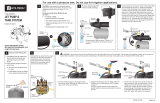
4
PREPARATION
Before beginning installation of product, make sure all parts are present. Compare parts with package
contents drawing. If any part is missing or damaged, do not attempt to assemble the product. Contact
customer service for replacement parts.
Estimated Installation Time: 2 hours.
Tools Required for Installation: Hacksaw, screwdriver, pliers, pipe vise, pipe wrenches (2), wire
cutters, wire strippers/crimpers, adjustable wrench (medium-large), Ohmmeter, propane torch, knife
or round le, small weight.
Materials Required for Installation: Submersible pump cable, power cable, pressure tank, shrink
tube & butt connectors, 1-1/4 in. check valve, torque arrestor, hose clamps, pipe ttings, pitless
adaptor or well seal, pressure switch, pressure gauge, pressure relief valve, tank cross, 1/4 in.
minimum safety rope, electrical tape,. You will also need either enough 1-1/4 in. Schedule 80 PVC pipe
to reach 20 ft. below the static level or 20 ft. below the drawdown level of your well, or coiled poly pipe
rated for 160 PSI. Poly pipe cannot be used for installations any deeper than 200 ft.
Optional Materials: 1-1/4 in. male barbed adaptor for use with poly pipe, cable guards to protect wire
inside the well, thread tape and thread paste.
Submersible Pump Cable and Power Cable Selection
Check cable size against Submersible Wire Size Chart below. Submersible power cable must be UL
listed for submersible pump applications. For Canadian installations, type RWU, TWU, SGOW or
SWOW power supply cable is recommended. Cable is selected for the maximum pump setting plus the
offset distance to the service entrance.
IMPORTANT: Use of wire sizes smaller than those specified in the chart will cause low starting
voltage, may cause early pump failure and will void the warranty. Larger wire sizes may always be used
for better economy of operation. Be sure voltage at pressure switch or fuse is between the following
limits:
115V Rated - Between 104 & 127 volts
230V Rated - Between 210 & 250 volts
NOTE: A small AWG number, i.e. 10 Ga., is larger in diameter than a large AWG number, i.e. 14 Ga.
The National Electric Code (NEC 250-43) requires a separate ground wire be run down the well to the
submersible pump and connected to all exposed metal parts of the pump and motor. Refer to the most
recent National Electric Code (NEC) Article 250 (grounding) for additional information.
NOTE: All wiring should be done by a qualified electrician.
DESCRIPTION QUANTITY
Pump 1
PACKAGE CONTENTS























